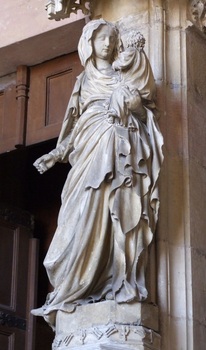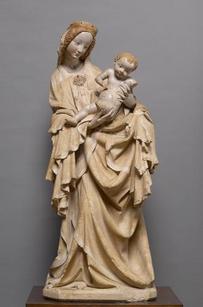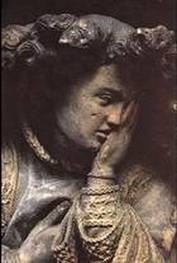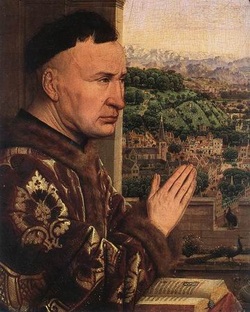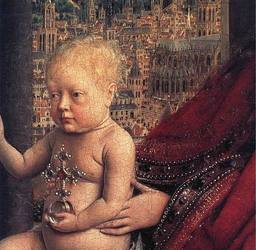The Transition
Jessica Dolezal
Leading in the transition from an International Gothic style to the more popularized and natural Renaissance style, Claus Sluter helped to change the way people viewed and interpreted art. Known most widely for his collection of sculptures at the Chartreuse de Champmol one would not expect anything less than marvelous from the hands of Claus Sluter.
The Well of Moses is one of Sluter’s most well-known and appreciated sculptures. Construction for the hexagonal structure began in 1393 and was to be a symbolic element of life. Six prophets and six weeping angels are among some of the features where the care and detail of Sluter’s work is most evident. Throughout Sluter’s work a continuous theme of naturalism and expression are present in almost every aspect. In the transition from a stylized genre to a more naturalized renaissance style, Claus Sluter was innovative on numerous levels. He is credited with being one of the first to emloy individualism to sculpture. This type of specification is visible in the faces of the angels and prophets that adorn the statue. The exquisite detail of the face and hair along with the natural flow of draping cloth are some of Sluter’s most signature and envied artistic qualities.
Jan Van Eyck, Rogier Van der Weyden and Mattias Gruenwald were said to have been influenced by the earthly naturalism of Claus Sluter’s work. The construction process for the Well of Moses was long and tedious. Having been employed by Philip the Bold, Sluter was able to work on this project over the course of several years, a luxury which not available to other artists attempting to work in a similar fashion. With the opportunity to decorate the Chartreuse de Champmol, Sluter utilized is artistic genius to create a number of remarkable pieces. Preceding the Well of Moses, Claus Sluter and his assistants began work on the Church Portal in 1389. The doorway was to include patronized images of Philip the Bold and his wife along with their personal saints, John the Baptist and Catherine of Alexandria. The same meticulous detail and naturalistic qualities are seen in this sculpture. Centered on a column dividing the two sets of doors, the virgin is depicted holding the Christ child. With the child resting its weight on one side of the virgin’s body a natural diagonal is created in the drapery. Neighboring either side of the virgin are kneeling figures who uphold the same type of renaissance naturalism Sluter is so widely recognized for. This image of the virgin is often compared with a similar piece created by an anonymous bohemian artist. Though the two sculptures are similar in content they vary quite differently in how they are presented and therefore give the viewer a different type of interpretation. The significance of Sluter’s naturalistic methods can be clearly seen when comparing the two Virgin and Childs together. The theatrics in the face of Sluter’s virgin are much more expressive and natural in comparison to the Krumau Virgin who appears much more unresponsive to the child in her arms. The weight distribution of Sluter’s virgin and child varies quite a bit and the result is much more “realistic” depiction. The child appears to have a significant weight, similar to what an actual child would and therefore the virgin’s stature is affected so. The earthly qualities are much more evident in Sluter’s and thus give credit to him as a pioneering artist.
The Well of Moses is one of Sluter’s most well-known and appreciated sculptures. Construction for the hexagonal structure began in 1393 and was to be a symbolic element of life. Six prophets and six weeping angels are among some of the features where the care and detail of Sluter’s work is most evident. Throughout Sluter’s work a continuous theme of naturalism and expression are present in almost every aspect. In the transition from a stylized genre to a more naturalized renaissance style, Claus Sluter was innovative on numerous levels. He is credited with being one of the first to emloy individualism to sculpture. This type of specification is visible in the faces of the angels and prophets that adorn the statue. The exquisite detail of the face and hair along with the natural flow of draping cloth are some of Sluter’s most signature and envied artistic qualities.
Jan Van Eyck, Rogier Van der Weyden and Mattias Gruenwald were said to have been influenced by the earthly naturalism of Claus Sluter’s work. The construction process for the Well of Moses was long and tedious. Having been employed by Philip the Bold, Sluter was able to work on this project over the course of several years, a luxury which not available to other artists attempting to work in a similar fashion. With the opportunity to decorate the Chartreuse de Champmol, Sluter utilized is artistic genius to create a number of remarkable pieces. Preceding the Well of Moses, Claus Sluter and his assistants began work on the Church Portal in 1389. The doorway was to include patronized images of Philip the Bold and his wife along with their personal saints, John the Baptist and Catherine of Alexandria. The same meticulous detail and naturalistic qualities are seen in this sculpture. Centered on a column dividing the two sets of doors, the virgin is depicted holding the Christ child. With the child resting its weight on one side of the virgin’s body a natural diagonal is created in the drapery. Neighboring either side of the virgin are kneeling figures who uphold the same type of renaissance naturalism Sluter is so widely recognized for. This image of the virgin is often compared with a similar piece created by an anonymous bohemian artist. Though the two sculptures are similar in content they vary quite differently in how they are presented and therefore give the viewer a different type of interpretation. The significance of Sluter’s naturalistic methods can be clearly seen when comparing the two Virgin and Childs together. The theatrics in the face of Sluter’s virgin are much more expressive and natural in comparison to the Krumau Virgin who appears much more unresponsive to the child in her arms. The weight distribution of Sluter’s virgin and child varies quite a bit and the result is much more “realistic” depiction. The child appears to have a significant weight, similar to what an actual child would and therefore the virgin’s stature is affected so. The earthly qualities are much more evident in Sluter’s and thus give credit to him as a pioneering artist.
The decorative elements were among the most crucial aspects of the Well of Moses. The six prophets, Zachariah, Jeremiah, Daniel, David, Moses and Isaiah are depicted with the outmost detail and individual characteristics. The hair, clothing, headpieces and facial expressions are unique to each individual which was unusual for that time period. This fact alone separates the work of Sluter from many other artists working in his day. Each of the prophets holds a scroll and though it too is made of stone it gives a light appearance due to the recoiling curls at the bottom. In addition thumb impressions can be seen on the scrolls, which once again magnify the significance of fine detail in Sluter’s sculptural works. Further detail continues above as angels are featured, mourning the death of Christ. Individual expression was vital for Sluter to continue featuring in order to maintain the already momentous structure he had created. In addition to utilizing naturalism in his artwork, Sluter also employed an element of psychology to evoke a desired emotion from his audience. A few of the angels wipe their tears while another crosses its arms and another holds its head in agony. Sluter utilizes these emotional details in the outmost fashion to bring full circle his artistic vision, not by chance but as pieces of his overall plan.
There are similarities shared between Claus Sluter and that of Jan Van Eyck. Though they are not working in the same format they uphold some of the same artistic qualities (fine detail, naturalism, etc.). The Virgin of Chancellor Rolin from 1435 is one of Van Eyck’s most widely recognized paintings. In comparison to Sluter one is able to see the attention to detail when depicting the drapery of cloth. The folds seem natural and would appear that the cloth has some weight to it. The facial expression may be minimal in this piece however detail is seen in the wrinkles and determined look of Chancellor Rolin’s face. The embellishments on the clothing and intricate detail of the carvings on the columns and arches are not forgotten but merely add to overall naturalized, earthly feeling that one gets from viewing this painting
Sluter’s supposed influence on Jan Van Eyck and many other artists sparked a new trend in the world of art as the shift from stylization to a classical renaissance style became more prominent. The mastery of natural detail, employment of psychological and theatrical expression is what separates Sluter as an artistic pioneer. Masterful works found at the Chartreuse de Champmol only justify the argument that Claus Sluter can be held responsible for what we now know as classical renaissance art.
Morand, Kathleen, Claus Sluter, and David Finn. Claus Sluter: Artist at the Court of Burgundy. Austin: University of Texas Press, 1991.
Nash, Susie, Claus Sluter's 'Well of Moses' for the Chartreuse de Champmol Reconsidered: Part I. The Burlington Magazine Vol. 147, No. 1233, Sculpture. 2005, pp. 798-809
Smith, Jeffrey Chipps. The Northern Renaissance . London: Phaidon, 2004.
Morand, Kathleen, Claus Sluter, and David Finn. Claus Sluter: Artist at the Court of Burgundy. Austin: University of Texas Press, 1991.
Nash, Susie, Claus Sluter's 'Well of Moses' for the Chartreuse de Champmol Reconsidered: Part I. The Burlington Magazine Vol. 147, No. 1233, Sculpture. 2005, pp. 798-809
Smith, Jeffrey Chipps. The Northern Renaissance . London: Phaidon, 2004.
